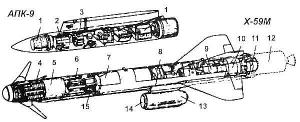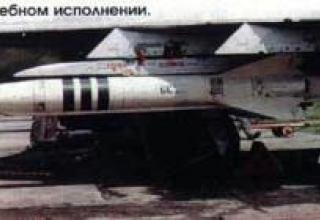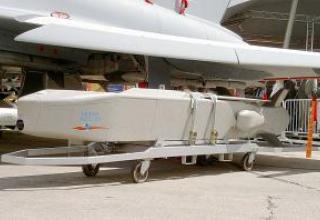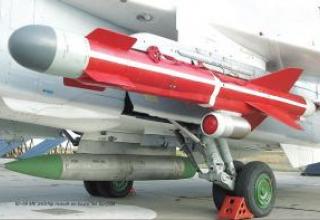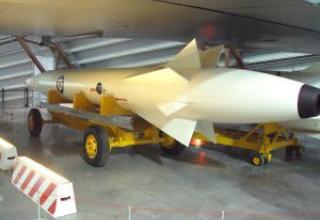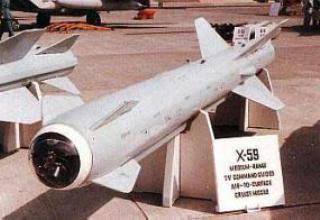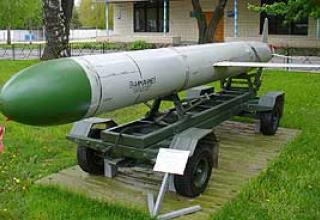The X-59M missile is designed to engage small ground and surface targets (at the sites of parking in the coastal zone and ports) with known coordinates, visually detected by the operator aircraft with a contrast on the ground 0.1 ... 0.3.
The missile was created in the ICB "Rainbow" under the guidance of General Designer I.Seleznev. Kh-59M is a deep upgrade of the X-59 missile with the replacement of the solid propellant marching engine by a small-size turbojet engine RDK-300, which led to the creation of virtually new missile system, radically different in design and characteristics.
The Su-24M weapon complex, equipped with SuO-1-6M on-board weapon control system and APK-9 overhead hardware container, could be used without any modifications to the aircraft. Tests of the X-59M were also started on the Su-27's impact modifications. The production of Kh-59 and Kh-59M missiles was mastered by the Smolensk Aviation Plant, but its deployment was hindered by the well-known problems of the early 1990s - the absence of a state order, almost complete cessation of financing and severance of economic ties (the manufacturer of fuel and lubricants and the Tekon-1 guidance system stayed in Lvov).
X-59 was used in the course of combat operations in Chechnya, where their targets were hideouts and warehouses of militants in the mountains. However, bad weather conditions, fog and poor visibility did not contribute to success. Hovering in snow-covered gorges and wooded mountains was quickly disrupted, and four launches were refused.
The complex was first shown at the Moscow Air Show MAKS-93. It is currently being offered for export under the designation "Ovod-ME". At MAKS-2009, Ovod-ME was presented in configuration versions with the X-59ME rocket and the upgraded X-59M2E. The variant of the complex with X-59M2E rocket (see photo) is designed to engage a wide range of fixed ground and surface targets with known coordinates and extended day and night conditions of application (in conditions of limited visibility, including night time). The X-59M2E guided missile is 30 kg heavier than the X-59ME and has a transmission-command guidance system with a high-sensitivity television camera.
ICB "Rainbow" offers upgraded versions of Kh-59M with increased range up to 285 km: anti-ship missile X-59MK with active homing radar head ARGS-59E and multi-target X-59MK2.
In the west, X-59M missile was designated AS-18 "Kazoo".
Composition:
The Ovod-M missile weapon system is a part of the Ovod-M missile system:
- X-59M missile;
- a universal hanging container;
- aircraft catapult launcher ;
- operator's console and target indicator.
The X-59M rocket is designed in accordance with the aerodynamic "tailless" scheme with an X-shaped wing and variable geometry destabilizer (see projections). In order to improve the survivability of the rocket is arranged in compartments. The controls are aerodynamic rudders.
Compared with the X-59 has undergone the greatest changes in the fuselage of the rocket, in which the former RDTT with side nozzles replaced the TRD RDK-300 in the fuselage in the gondola. In the central part of the fuselage was placed a large fuel tank - a compartment with a drainage system and filling the throat for conventional aviation kerosene. In the rear part of the fuselage there remained the launch unit RDT, which supports the specified high-speed mode for launching the marching TRD after separation of the rocket. After its firing, the air intake coke fairing, which protects the entrance to the engine from debris during take-off of the carrier aircraft, is reset and further flight is carried out using TRD.
The peculiarity of the X-59M aerodynamic scheme was the increase in the scale of communication destabilizers with a large mass and dimensions of the product. Their "whiskers", at startup are turned by springs and become on clips. Providing advance shift of aerodynamic focus and acceptable controllability characteristics while maintaining the required power of steering drives. The use of TRD required changes in the composition of the SAU, which received the engine regulator unit that starts the engine and controls the maintenance of operation mode with fuel supply and high-speed correction.
The range of the communication line was 140 km, which ensured a firing range of up to 120 km. The X-59M can be launched from low altitudes (up to 100 m) and perform a low-altitude flight to the target at a given altitude (from 50 to 1000 m), provided by SNAU and radio altimeter. Released layout volumes of the former RDTT section were used to accommodate twice the capacity of the BC. In addition to the penetrating BC weighing 320 kg, there is a cassette BC weighing 280 kg with separate shrapnel and cumulative impact elements. The accuracy of firing at the maximum range is comparable with X-59 and equals 2-3 meters.
To place the X-59M on the carrier the same device AKU-58-1 served.
All units of the fuselage of the rocket docked on quick-connectors. The nose coc is discharged, made of AMG-6 material. Cargo compartment - made of VNS-2 material, wing sheathing made of AMG-6, spars from ON-3. Fuselage compartments have internal thermal insulation made of ATM9-200 material glued to the wing liner with the glue BK-9.
The X-59M control system is a combined, high-precision TV-command system with a radio altimeter and command transmission over a radio line, similar to the X-59 missile. At the initial stage on the television image transmitted from the board of the rocket, the operator of radio commands leads it to the target, at approaching the target turns on a television homing head.
To use the X-59M missile on the carrier aircraft it is necessary to have a special hanging container like APK-8 or APK-9. The use of the container in the complex of missile weapons makes it possible to use the X-59M missile from various carriers, including foreign, including the main tactical fighters such as "Mirage-3", F-15, F-16.
The X-59M missile flight control equipment container consists of four cylindrical-shaped compartments. The nose and tail fairings have radio transparent coca and are riveted to "skirts" made of D-19 material. Frames are made of EI-654 material, frame is made of VKL-3 and 12Х2НВФА, cladding is made of D-19 material.
Characteristics:
| Range of fire, km | |
| - minimum | 10-15 |
| - maximum | 120 |
| - automatic guidance | 40 |
| Control range, km | 140 |
| Shooting accuracy (CWO), m | 2-3 |
| Flight Speed, km/h. | 860-1000 |
| Height of flight over the sea, m | 7 |
| Flying height above ground, m | 50,100,200,600,1000 |
| Airplane carrier | MiG-29K, Su-30M, Su-24M. |
| Flying speed of the carrier, km/h | 600-1100 |
| Launch height, m | 200-5000 |
| Number of rockets on the carrier | 2 |
| The length of the rocket, mm | 5690 |
| Maximum rocket body diameter, mm | 380 |
| Wingspan, mm | 1260-1300 |
| Start weight , kg | 920 (960 for X-59M2E) |
| Battle unit weight (penetrating / cassette) , kg | 320/ 280 |
| Control equipment: | |
| Developer | Rainbow ICB |
| Range of communication line, km | 140 |
| Length, mm | 4000 |
| Diameter, mm | 450 |
| Weight, kg | 260 |
| Aircraft launcher | |
| Type | ACU-58-1 |
| Число ракет на ПУ | 1 |
| Developer | Vimpel ICB |
| Weight of empty PU, kg | 185 |
| Length PU, mm | 3810 |
| PU width, mm | 130 |
| Height PU, mm | 220 |
Testing:
The first flight of the prototype carrier aircraft Tu-95M-55 (BM-021) took place on July 31, 1978. A total of 107 flights and launches of ten X-55s were made on this machine by the beginning of 1982. The plane was lost in the crash January 28, 1982 on takeoff from Zhukovsky because of pilot error.
The tests of the X-55 were very intensive, which was facilitated by a thorough pre-testing of the control system on the model stands of NIIAS. During the first stage of the tests 12 launches were conducted, only one of which failed due to the power system generator failure. In addition to the missile itself, the weapon control system was brought to the surface of the launch vehicle, which was used to launch the mission and exhibit the missile's gyroinertial platforms.
The first launch of the serial X-55 was made February 23, 1981. September 3, 1981 the first set-off launch was made with the first production car Tu-95MS. Tests of the complex were conducted on the route measuring complex of the 929th LIC. Test launches of X-55 were carried out virtually the entire range of flight modes of the carrier from altitudes of 200m to 10km. The engine was launched reliably, the speed on the route, adjustable depending on weight loss during fuel production, was maintained in the range of 720-830 km/h. With a given value of CVO not more than 100m in a number of starts a deviation of only 20-30m was achieved.
The first to master the new complex started in Semipalatinsk 1223rd TBAP, which on December 17, 1982. arrived two new Tu-95MS. Since 1984, retraining on the Tu-95MS began adjacent 1226th TBAP of the same Semipalatinsk 79th TBAD. At the same time there was equipping of Tu-95MS regiments YES in the European part of the USSR - 1006 TBAP in Uzin near Kiev and 182nd TBAP in Mozdok, which was part of the 106th TBAD. In the division were concentrated more advanced Tu-95MS-16. The first Tu-160 arrived in April 1987 in the 184th TBAP, which was located in Priluki in Ukraine. Three months later, August 1, 1987 the crew of regiment commander V.Grebennikov first performed the launch of X-55.
After the collapse of the USSR, most of the X-55 missiles and their carrier aircraft remained outside Russia, in particular, in Kazakhstan and Ukraine, where there were, respectively, 40 Tu-95MS in Semipalatinsk, 25 in Uzin and 21 Tu-160 in Priluki. Together with the aircraft in the Ukrainian bases remained 1068 missiles X-55. With Kazakhstan, we managed to agree quickly enough, exchanging heavy bombers for proposed Russian fighters and attack aircraft. By February 19, 1994 all TU-95MS were ferried to the Far Eastern airfields, where they were equipped with the 182nd and 79th TBAP. The negotiations with Ukraine lasted a long time. Eventually, three TU-95MS and eight TU-160, which flew to Engels in February 2000, were transferred by the Ukrainian side on account of debts for gas. At the end of 1999, 575 air-based cruise missiles X-55 and X-55SM were also delivered from Ukraine to Russia.
In the Russian Air Force, all the forces of the YES were combined into the 37th Air Force. In its composition by July 2001, there were 63 Tu-95MS aircraft with 504 missiles Kh-55, as well as 15 Tu-160. The first practical launch of X-55SM from the Tu-160 was made by the crew of Colonel A. Zhikharev October 22, 1992. In June 1994, four Tu-95MS and Tu-160 took part in the exercises of the Russian Strategic Nuclear Forces, having worked out tactical launches over the North Sea and then executed the actual firing of X-55SM at the range. In September 1998, a group of four Tu-95MS 184th TBAP were made launches of X-55 in the area of the Northern Fleet training ground Chizha, where the missiles were 1500 km to the target.
During the exercise "West 99" in June 1999, a pair of Tu-95MS from Engels performed a 15-hour flight, reaching Iceland, and on the way back made a launch of X-55 on a training target in the Caspian Sea. In October 2002, the crew of the Tu-160 Colonel Yu Deineko in a night flight passed the route over the circumpolar areas, performing a practical launch of X-55SM. May 14, 2003 the four Tu-95MS and six Tu-160 participated in exercises covering the Persian Gulf and the Indian Ocean. Launches of the X-55 from the Tu-95MS were held during the strategic command training of land, sea and air SNF in February 2004.
Sources:
- А.В.Карпенко, С.М. Ганин "Отечественные авиационные тактические ракеты", "Бастион" N1, 2000г.
- Основные образцы и модификации самолетов, ракет и товаров народного потребления (ТНП),освоенные производством ДМЗ с 1951 г. по 1996 г., и их технологические особенности (http://www.dubna.ru)
- Ракета Х-59МК2
- Ракета Х-59МК


